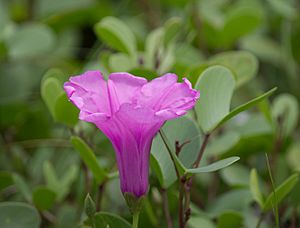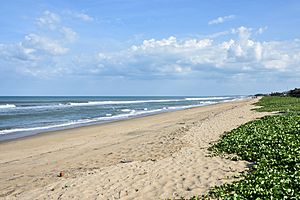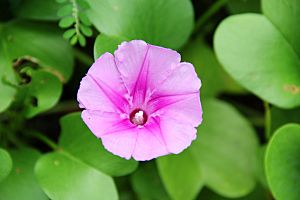Bayhops facts for kids
Quick facts for kids Bayhops |
|
|---|---|
 |
|
| A beautiful flower of the beach morning glory plant on a beach in Kerala. | |
| Conservation status | |
| Scientific classification | |
| Genus: |
Ipomoea
|
| Species: |
pes-caprae
|
| Synonyms | |
|
Convolvulus pes-caprae L. |
|
Ipomoea pes-caprae, also known as bayhops, beach morning glory, railroad vine, or goat's foot, is a common plant found all over the tropical parts of the world. It is a vine that creeps along the ground and belongs to the Convolvulaceae family. This plant loves to grow on the upper parts of beaches and can handle salty air and water.
It is one of the most common salt-tolerant plants and is a great example of how seeds can travel across oceans. Its seeds can float and are not harmed by salt water. This plant was first described by Carl Linnaeus and later placed into its current group by Robert Brown in 1818.
Contents
What Does Beach Morning Glory Look Like?
The beach morning glory is a plant that lives for many years. It often covers large areas of sand. Its stems are long and trail along the ground, sometimes reaching several meters. These stems can even grow roots where they touch the ground.
The plant has pretty pink flowers with a darker center. After the flowers, it grows a fruit that looks like a capsule. This capsule holds four hairy seeds that can float in water.
Where Does Beach Morning Glory Grow?

You can find this plant on the sandy shores of tropical areas around the Atlantic, Pacific, and Indian Oceans. A similar plant, Ipomoea imperati, has white flowers and grows in even more places on beaches worldwide.
I. pes-caprae is very common on the sand dunes along the northern coast of New South Wales in Australia. It also grows all along the Queensland coastline.
How Beach Morning Glory Helps Beaches
The goat's foot plant is very important for keeping sand in place. It is one of the first plants to grow on sand dunes. It can grow on almost all parts of dunes, but you usually see it on the slopes facing the ocean. Its long runners spread down towards the bottom of the dune.
These spreading runners come from a strong, woody root. The plant's large leaves have two lobes, but they are not very dense. This means the plant usually doesn't cover the sand completely, unless it's in a very protected spot. This plant grows well with Spinifex grass. It is great at holding sand and thrives even when sand is blowing around and salt spray is in the air.
This plant often grows with other tough species that can handle difficult conditions on dunes. For example, it can be found with:
- Hydrocotyle bonariensis
- Senecio crassiflorus
- Juncus acutus
Along with plants like Melanthera biflora, Portulaca oleracea, and Digitaria ciliaris, beach morning glory is often one of the first plants to grow in areas that have been damaged or changed in tropical regions.
Uses of Beach Morning Glory
People in different parts of the world use the beach morning glory for various purposes.
- In Australia, Aboriginal people commonly use it as a traditional medicine. They make a poultice (a soft, moist mass) from the plant to treat stings from stingrays and stonefish.
- In Brazil, a type of this plant, called brasiliensis, is known as salsa-da-praia in folk medicine. It is used to help with inflammation and problems with the stomach and intestines.
- In the Philippines, the plant is called Bagasua by local people. It is used to treat conditions like rheumatism (joint pain), colic (stomach pain), oedema (swelling), whitlow (finger infection), and piles (hemorrhoids).
What Does the Name Mean?
The scientific name I. pes-caprae comes from Latin words. 'Pes' means 'foot' and 'caprae' means 'goat'. This name was chosen because the shape of the plant's leaf looks a lot like a goat's footprint.
Gallery
-
Beach morning glory in Malaysia.
See also
 In Spanish: Ipomoea pes-caprae para niños
In Spanish: Ipomoea pes-caprae para niños









